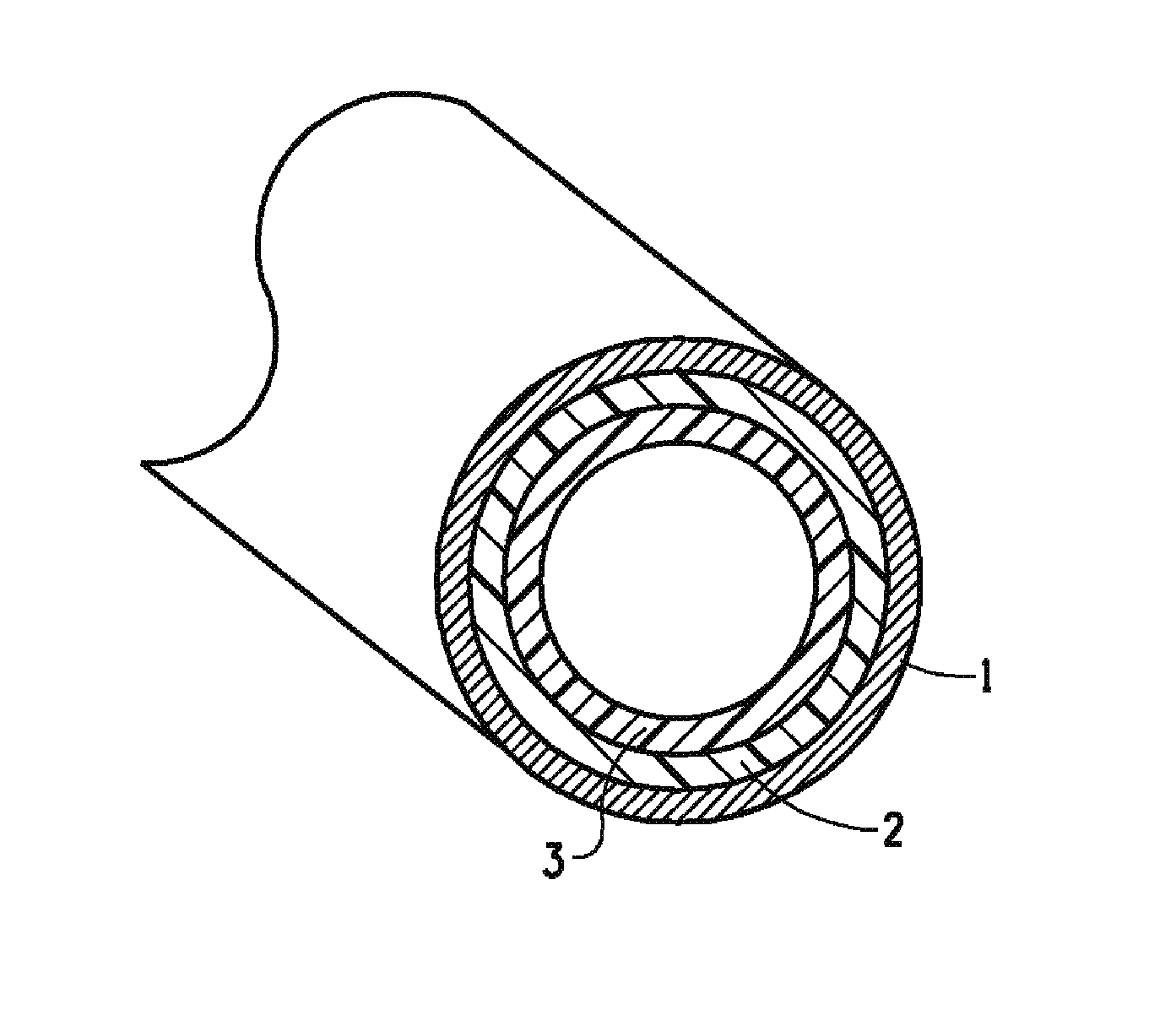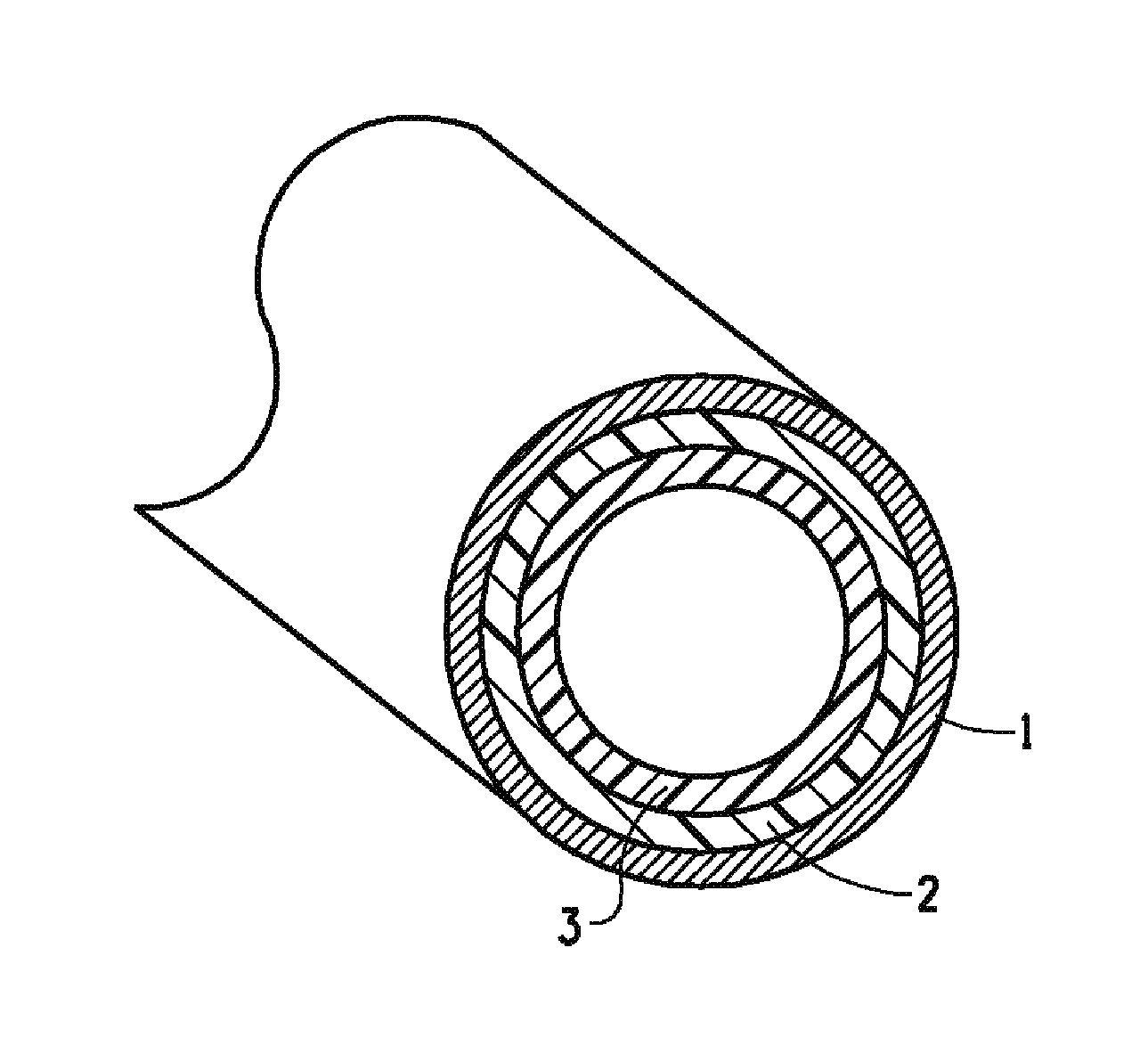Pipe interior coatings
a technology for interior surfaces and pipes, applied in the field of pipes, can solve the problems of increasing the difficulty of passing autoclave and acid soak tests, and severe test conditions used to obtain level 1 ratings
- Summary
- Abstract
- Description
- Claims
- Application Information
AI Technical Summary
Benefits of technology
Problems solved by technology
Method used
Image
Examples
example 1
[0072]A layer of primer 1 containing polymer binder and no fluoropolymer is applied to a set of prepared carbon steel panels, followed by baking at 550° F. (288° C.) for 10 minutes. The dry film thickness (DFT) of the primer layer is 0.91 mil (22.7 um).
[0073]An inner layer coating 1, containing about 25% pigment and having a FP / binder ratio of about 50 / 50, is applied over the baked primer layer. The inner layer (midcoat) is baked at 700° F. (371° C.) for 20 minutes. The DFT of the resultant inner layer is 1.6 mil (40 um). An outer layer coating (topcoat) 2 is applied to the baked inner layer. The outer layer is baked at 700° F. (371° C.) for 20 minutes. The DFT of the baked outer layer is 1.92 mil (48 um). The total DFT of the three coat system is 4.43 mil (111 um) and the combined thickness of the inner and outer layers is 3.52 mil (88 um).
[0074]Coated panels are subjected to the Autoclave Test to test adhesion of the nonstick coat to the metal substrate as described in the Test Me...
example 2
[0076]Similar to Example 1, but using primer 2 containing polymer binder and 5% PTFE micropowder, applied to a set of prepared carbon steel panels, followed by baking in the range of 650° F.-700° F. (343-371° C.) for 10 minutes. The dry film thickness (DFT) of the primer layer is 1.07 mil (27 um).
[0077]The same inner and outer layer coating compositions used in Example 1 are applied using the same baking conditions. The DFT of the inner layer is 1.74 mil (43.5 um). The DFT of the outer layer is 1.61 mil (40 um). The total DFT of the three coat system is 4.42 mil (110.5 um) and the combined thickness of the inner and outer layers is 3.35 mil (84 um).
[0078]Coated panels are subjected to both the Autoclave Test and the Acid Soak Test. Test conditions and results are presented in Table 3. Panels with this coating system have very good intercoat adhesion as well as good adhesion to the metal substrates with very good blister ratings. The non-stick coating of this Example passes the Level...
example 3
No Pigment in Inner Layer
[0079]A layer of primer 2 containing polymer binder and 5% PTFE micropowder is applied to a set of prepared carbon steel panels, followed by baking at 650° F. (343° C.) for 10 minutes. The dry film thickness (DFT) of the primer layer is 0.83 mil (21 um).
[0080]Inner layer coating 3, containing no pigment and having a FP / binder ratio of about 30 / 70, is applied over the baked primer layer and is baked at 700° F. (371° C.) for 20 minutes. The DFT of the inner layer is 1.55 mil (39 um). Outer layer coating 2 is applied and is baked at 700° F. (371° C.) for 20 minutes. The DFT of the outer layer is 1.6 mil (40 um). The total DFT of the three coat system is 4.02 mil (100.5 um) and the combined thickness of the inner and outer layers is 3.19 mil (80 um).
[0081]Coated panels are subjected to both the Autoclave Test and the Acid Soak Test. Test conditions and results are presented in Table 3. Panels with this coating system have very good intercoat adhesion as well as ...
PUM
| Property | Measurement | Unit |
|---|---|---|
| thick | aaaaa | aaaaa |
| thick | aaaaa | aaaaa |
| thick | aaaaa | aaaaa |
Abstract
Description
Claims
Application Information
 Login to View More
Login to View More - R&D
- Intellectual Property
- Life Sciences
- Materials
- Tech Scout
- Unparalleled Data Quality
- Higher Quality Content
- 60% Fewer Hallucinations
Browse by: Latest US Patents, China's latest patents, Technical Efficacy Thesaurus, Application Domain, Technology Topic, Popular Technical Reports.
© 2025 PatSnap. All rights reserved.Legal|Privacy policy|Modern Slavery Act Transparency Statement|Sitemap|About US| Contact US: help@patsnap.com



